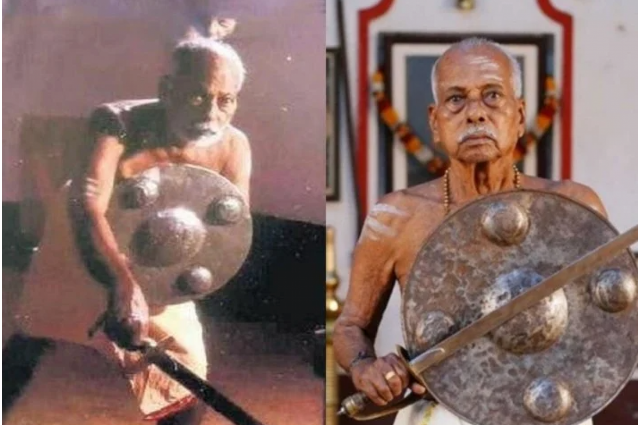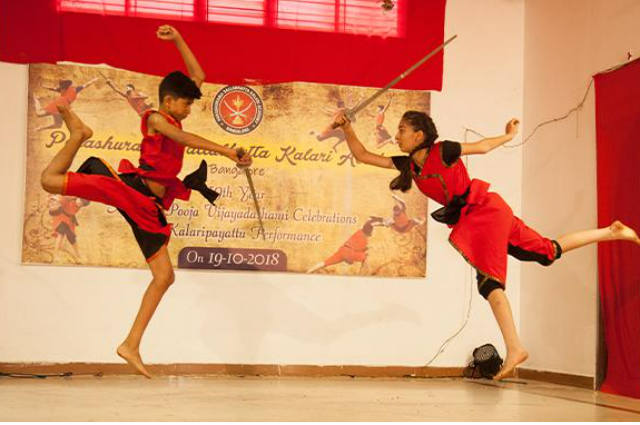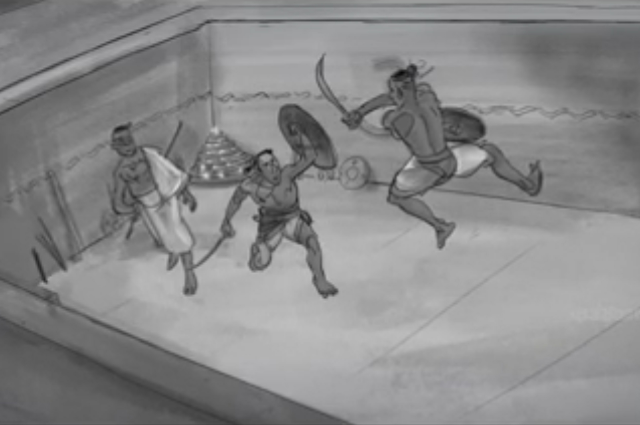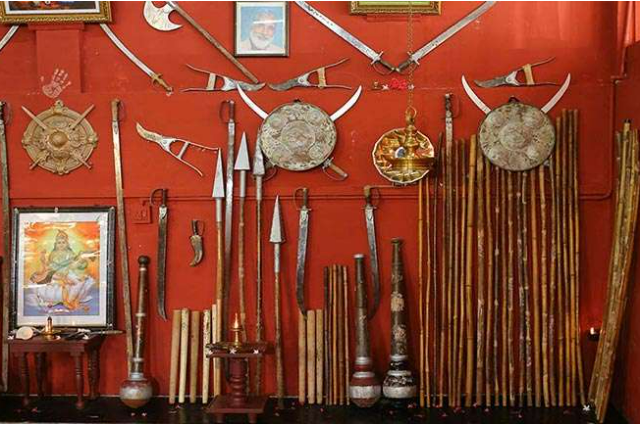INTRODUCTION WITH A BLEND OF HISTORY:
WARS. Now, this definitely something that has kept on happening since the beginning of human existence. History has shown us that the art of waging a war has seen constant changes, developments, and immense styles over the course of time in different parts of the world. Brazil has got Capoeira, China has got Tai Chi, the Japanese proudly has introduced Taekwondo. And my country INDIA has got the mother of all these martial arts. Yes, you guessed it right.
KALARIPAYATTU.
It is been said that this form of martial art is the most ancient and is one of the most efficient proven ways of fair combat, happens to have been innated and instigated in God’s own country aka Kerala. However, the exact time of when this art came into existence is unknown or cannot be said with complete surety and is itself a debatable topic.
Some people argue that kalaripayattu in its unrefined and crude form was practiced unknowingly by our stone-age ancestors as a sole base of defense and also to overpower their foes.
Mythology lovers would like to believe that it has a platitudinous past, by stating that it was introduced by Lord Parashurama after he re demanded the land from the Arabian sea.
In order to save the land from the sea, the lord set up 1008 kalaris (training centers) so as to stop the ground from shaking.
Historians amenably reject this idea of stating the derivation and prerogatives that there is no accord among them either, with their fastening of time of its birth anywhere in between 200BCE and 600 CE and its inflating popularity between the 14th and 16th centuries. And the historians are of the opinion that it was developed by the soldiers of Kerala when war broke out between the Chola and the Chera dynasties. Readers their debate is unstoppable.. let's move on... Kalaripayattu was simply available to all the people irrespective of their caste, gender, or creed since the time of its origin. Now that’s something which makes Kalaripayattu empowering.
KALARIS (TRAINING CENTERS):
They are said to be constructed in two ways.
1) By digging a rectangular pit in the ground, often referred to as the Kuzhi kalari (Just like how you see in the picture below.)
2) The other is made by enclosing a flat patch of open ground with pillars.
WEAPONS USED IN KALARIPAYATTU - The Weapon Skills
The use of weapons is inevitable to this martial art and is certainly its integral part.
It takes a lot of hard work sweat and consistent dedication to master the weapon skills of kalaripayttu. Weapons are treated as an extension of the body to be diligently used in a variety of fighting contexts. As per this art, there are just 5 parts of our human body that can be accurately attacked with weapons when the base safety stance is engaged. These five parts are oathiram (head), olavu(the two sides of the face), poravu (between shoulders and elbows), katakam(below knees), and vaari (sides of the body on the ribcage) The attack and their respective defense moves are confined and centered around these five body parts.
SKILLS THAT A TRUE KALARI FIGHTER SHOULD POSSESS:
The essential required qualities are often compared to the qualities that the indian animals symbolises. Hmm, now that’s interesting. Lemme just put it this way
- Simhasya garjanam - which means the fighter should have the roar of a lion.
- Vygrasya Sikram - that accounts to having the speed of a cheetah
- Marjara lagavam - to be as flexible and agile as a cat.
Now don’t freak out that saying damnn... I don’t roar like a lion nor do I have the speed of a cheetah. Chill, Understand the figure of speech Simile and also the very fact that skills are something that you acquire over a period of time via consistent practice.
HOW MUCH TIME SHOULD WE INVEST IN MASTERING THIS ART?
Experts say that kalari is a lifelong learning process. However out of the four parts of kalaripayattu usually students master the first step of basic exercises (meipayattu) in about 3 months, the other 3 parts the totally subjective and vary from individual to individual based on their efforts and dedication.
BENEFITS OF ACQUIRING KNOWLEDGE AND PRACTISING THIS ICONIC MARTIAL ART:
Benefits, profits, outcomes, gains, and all the other synonyms. We homo sapiens are obsessed with the upshots or consequences that we acquire at the end of any process and yeah it is pretty human to think that way. Listed below are some of the various rewards that you will procure after practicing KALARIPAYTTU.
Improves your body flexibility, it's an excellent art for self-defense. Helps to gain control over your mind, enhances your concentration skills, tests and improves the presence of mind, improves your physical fitness, inflates body stamina, positive behavior, and interaction with others.
A kalari practitioner exactly knows how to keep his/her calm and act in a controlled and composed manner.
HERE’S MORE!!
THE SHOW IS STILL ON.
Let's now dive and venture into the interviews of some popular kalaripayattu Gurus to have a deeper and spiritual understanding about this master art.

Source: youtube.com/c/digg
SRI RAJ DEVI PRASAD Sir ji. He’s currently serving as the guru at ‘SREE BHARATH KALARI’ (SBK), which was founded by his father late Chirkakkal T Sreedharan Nair in 1948.
“Kalaripayattu in short if I have to say is the defensive art of Kerala, it is Kerala's own martial tradition. It traveled abroad and influenced even other martial art forms. That is exactly how karate, kung fu, and even jiu-jitsu spread in China and East Asia.”
Talking about the structure of kalaripayttu, sir mentioned that it is practiced inside a kalari, Kalari is also specially made, the upper soil is removed to a depth of maybe 3-4 feet. And in one corner there will be a presiding deity which we call puttara and there is another place opposite to this called the guruthara which is dedicated to the preceptors of kalaripayttu.
The practice of this art is also divided into four parts.
- Maipayat - means the body conditioning exercises wherein there is a maximum or exaggerated use of all the joints and muscles are involved in these body exercises, they are even choreographed to form a series of exercises.
- Koltharipayattu - wooden weapons like long canes, short staffs, bent ones -otta- a horn-like weapon. In this part, there is these Vaiitharis (oral commands) Firstly starting with the long staff - kettukaari, there are 10 series in that, each set to balanced oral commands.
- Ankatharipattu - sharp weapons usage like sword, shield, spear, dagger and flexible sword urumi. And it is said that urumi was once upon a time-worn around the waist of a person and people used to carry this as a secret weapon.
- The last part Verumkai - the bare-handed defense and attack, so after learning that and acquiring the needed skills and reflexes for that he/she will be able to defend any attack from any quarters with any kind of weapons.
I bet you that interview was indeed supremely informative.
NOW WE ARE BACK TO 2022 FROM THE 14th century aren’t we?
Here’s a true gem source of inspiration.
NOTE THIS NAME...
MR. SANKARANARAYANA MENON
THE 93-year-old Kalaripayattu upholder who received the PADMA SHRI for his notable and magnificent contributions in the field of Martial arts. (2022)
NOW let's hear him out and celebrate his victory !!!
HIS-STORY (EXCLUSIVELY):

“I am obviously glad that the government has recognised me. But it's not the end. I will continue teaching students as long as I am alive. It's my duty” said MR. Menon in a mellow but clear tone.
The 26th of January 2022 embarked just like any other regular day for Sankaranarayana Menon but ended with a huge downpour of appreciation but with a tincture of less celebration as he has been rewarded with the Padma Shri for his exemplary contribution in the field of martial arts. The routine that Menon has been accustomed to since a very long time commences by waking up every morning at 5, then take a cold shower in the traditional family pond, offer his sincere prayers to the family deity (courtyard temple) and then enter the kalari where his students are eagerly waiting for him all set and prepped up to give in the next 3-3.5 hours to receive some enervating tutoring of body and mind.
Nowadays his body doesn’t allow him to perform the rigorous complicated steps, but that doesn’t stop him from imparting knowledge to his students. He makes learning fun by reciting the oral commands through folk songs. He learnt it from his forefathers but Menon very humbly states that he can efficiently perform most of the adavu without cracking a bone or muscle. This proves the fact that the adavus of kalari has become part and parcel of his life.
He has traveled to various places abroad to spread the art of kalaripayattu along with some of his students. He has successfully set up kalari training centers in countries like the France, UK, US, Belgium, and Sri Lanka. As of now he has established around 17 branches worldwide and is presently training 5000 people. .
“I have been practicing those moves since I was seven, so it has become a part of me, like my mind. I feel I need to finetune some of the steps,” he says.
In the best traditions of kalaripayattu, Menon has a taut and supple border. Says his son Krishnadas: “We don’t look to build big muscles like pehelwans, but rather compact muscles that give us flexibility and make reflexes stronger. My father had a perfect kalaripayattu physique and, in his prime, was known for his dexterous moves.”
Menon says that he would continue to impart knowledge to the students as long as he is life. That definitely sparkles his zeal and true dedication towards Kalaripayattu.
KALARIPAYATTU IS NOT JUST A MARTIAL ART OR YET ANOTHER INDIAN ANCIENT SPORT. IT IS A WAY OF LIFE.
SO what are you waiting for? Christmas?
You just discovered a new skill to master. Happy learning.




